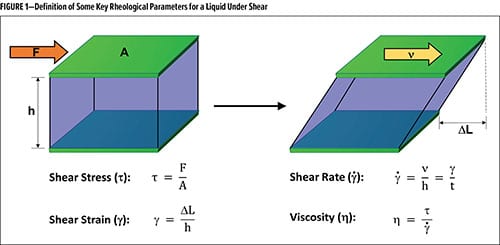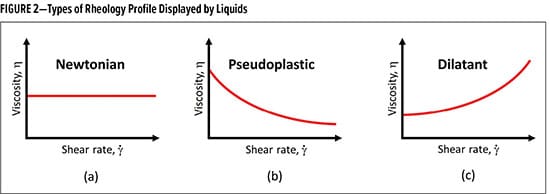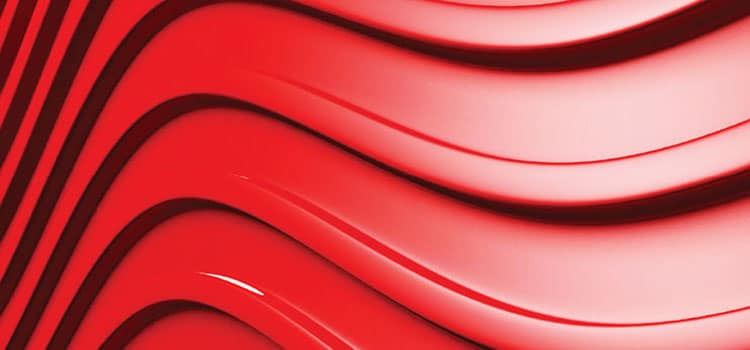By Leo Procopio, Paintology Coatings Research, LLC
Formulating paints and coatings to provide the right balance of properties is a complex undertaking. Getting the rheology profile correct is just one important task on the formulator’s to-do list, but it is crucial to the ultimate success of the coating.
The rheology profile influences properties of the coating throughout its lifetime, from manufacture, storage, mixing, and application, to the resulting film properties. To control and optimize the rheology of liquid coatings, the formulator typically relies on additives, often referred to as rheology modifiers, thickeners, and thixotropes.
This article reviews some of the basics of rheology and rheological additives and includes comments from a roundtable discussion with industry experts on existing challenges and new developments.
BASICS OF RHEOLOGY
Rheology is defined as the science examining the flow and deformation of materials. When considering fluids such as liquid paints and coatings, the aspect of rheology discussed most often is viscosity. The viscosity of a fluid is a measure of its resistance to deformation under a given stress and is a material property that we associate with the coating as being either “thick” or “thin.” To understand viscosity and its importance for coatings, a quick review of the principles is helpful.
 As Isaac Newton did many years ago, consider a fluid between two plates as in Figure 1, where the bottom plate is static, and the top plate is moving at a certain velocity (𝑣) due to an applied force (F). When a force is applied to the liquid, flow of the liquid will occur to relieve the strain from the force.
As Isaac Newton did many years ago, consider a fluid between two plates as in Figure 1, where the bottom plate is static, and the top plate is moving at a certain velocity (𝑣) due to an applied force (F). When a force is applied to the liquid, flow of the liquid will occur to relieve the strain from the force.
The shear stress (τ) is defined as the shear force (F) per unit area (A) that results in flow of the liquid and has units of Pascals (1 Pa = 1 N/m2) or dyne/cm2. The shear strain (𝑦) describes the deformation of the fluid and is defined as the ratio of the horizontal displacement (ΔL) to the height (h). The velocity of a fluid layer near the top plate will be higher than the velocity of a fluid layer near the bottom static plate.
 Shear rate (ẏ) describes the velocity gradient, or the change in liquid velocity per unit height between the shear plates, and is defined as 𝑣/h, where 𝑣= ΔL /t, and t is the time it takes the top plate to move the distance ΔL. Shear rate has units of reciprocal seconds (s-1). Viscosity, which we already noted is a measure of the resistance of the fluid to deformation, is the ratio of shear stress (τ) to shear rate (ẏ), and is reported in units of Pa•s or dyne•s/cm2 (where 1 dyne•s/cm2 = 1 Poise (P), and 1 Poise equals 0.1 Pa•s.
Shear rate (ẏ) describes the velocity gradient, or the change in liquid velocity per unit height between the shear plates, and is defined as 𝑣/h, where 𝑣= ΔL /t, and t is the time it takes the top plate to move the distance ΔL. Shear rate has units of reciprocal seconds (s-1). Viscosity, which we already noted is a measure of the resistance of the fluid to deformation, is the ratio of shear stress (τ) to shear rate (ẏ), and is reported in units of Pa•s or dyne•s/cm2 (where 1 dyne•s/cm2 = 1 Poise (P), and 1 Poise equals 0.1 Pa•s.
When the viscosity of a fluid is constant at varying shear rates, it is said to exhibit ideal or Newtonian viscosity (Figure 2a). Newtonian fluids include simple fluids such as water, solvents, and oils. However, most liquid materials, including paints and coatings, are non-Newtonian in nature, and have a viscosity that changes with shear rate. The viscosity of paints and coatings generally decreases with increasing shear rate, also known as shear-thinning or pseudoplastic behavior (Figure 2b). Shearing the coating will break down structure within the liquid, and lead to a lower viscosity versus when the coating is at rest and unperturbed.
Some fluids, such as high-solids dispersions, can show an increase in viscosity with increasing shear rate, also known as shear-thickening or dilatant behavior (Figure 2c). Generally, dilatant flow is not desired, as it can cause problems during manufacture and in processes such as mixing and pumping.
